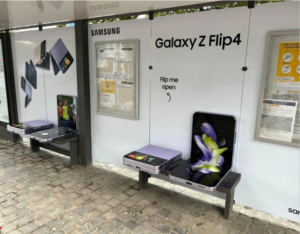A Comprehensive Guerrilla Marketing Guide for Small Businesses
Since Covid-19, companies big and small are facing hard decisions regarding budget. The economic turbulence is an added factor for cost-cutting, specially, in the marketing and advertising budgets. Businesses are trying to stay afloat hens, the reduced marketing budget.
We have wrongly believed that there is no room for creativity and small budget campaigns that have the potential to spread like wildfire.
We will go through one of the cost-effective marketing approaches “Guerrilla Marketing” that has the potential to raise awareness and promote a new product or service.
What is Guerrilla Marketing?
Guerrilla Marketing is one of the approaches to create a low-budget campaign that reaches a targeted audience and generates word of mouth. Guerrilla Marketing is a corporate campaign that surprises, delight and elicits an emotional response from the audience, in a non-intrusive manner. Guerrilla marketing is usually a non-traditional budget-friendly campaign to a specific group of people, delightfully interrupting their everyday life.
Guerrilla marketing allows marketers to get creative in creating a potentially viral campaign while staying true to their brands.
In short, Guerrilla Marketing is a fun campaign executed on a low budget to generate buzz in public spaces.
History of Guerrilla Marketing
The term guerrilla marketing was first coined back in 1984 by advertising executive Jay Conrad Levinson and it’s borrowed from the military vocabulary.
Jay Conrad Levinson:
- The author of more than a dozen books in the Guerrilla Marketing series.
- Early Career: his career started in advertising at Leo Burnett and JWT, working on revolutionary campaigns.
- A former vice president and creative director at J. Walter Thompson Advertising and Leo Burnett Advertising.
- Conceptualised guerrilla marketing—fun campaigns executed on a low budget to generate buzz in public spaces.
- Chairman of Guerrilla Marketing International, a consulting firm serving large and small businesses worldwide.
The Military concept of “Guerilla Warfare” relied on non-traditional tactics. The use of guerrilla warfare was first suggested in the 6th century BC by Chinese general and strategist Sun Tzu, in his classic book, The Art of War.
Guerrilla marketing requires a lot of planning and time; to study the most relevant medium, type of audience because how well your message surprises and delights your targeted audience the more it is destined to create a positive world of mouth and virality.
Guerrilla Marketing in Levinson’s Words
“The soul and essence of guerrilla marketing [is] achieving conventional goals, such as profits and joy, with unconventional methods, such as investing energy instead of money,” remarked Levinson. “Guerrilla marketing has been proven in action to work for small businesses around the world. It works because it’s simple to understand, easy to implement, and outrageously inexpensive.”
Pros of Guerrilla Marketing
- Cheap to execute: Whether using a simple stencil or a giant sticker, guerrilla marketing tends to be much cheaper than classic advertising. So, this sort of campaign works pretty well for small businesses.
- Allows for creative thinking: With guerrilla marketing, imagination is more important than budget.
- Grows with word-of-mouth: Guerrilla marketing relies heavily on word-of-mouth marketing, considered by many one of the most powerful weapons in a marketer’s arsenal. There’s nothing better than getting people to talk about your campaign on their own accord.
- Publicity can snowball: Some especially noteworthy or unique guerrilla marketing campaigns get picked up by local (and even national) news sources, resulting in a publicity powerhouse effect that marketers live for.
Cons of Guerrilla Marketing
- Mysterious messages can be misunderstood: There’s often an air of mystery to guerrilla marketing campaigns, and while it’s this sense of mystery that can often propel a campaign’s attention and notice, the lack of clarity can also skew audience interpretation.
- Authority intervention: Some forms of guerrilla marketing, such as non-permissioned street graffiti, can result in tension with authorities.
- Unpredicted obstacles: Many guerrilla marketing tactics are susceptible to bad weather, thrown timing, and other small instances that could easily threaten to undermine an entire campaign.
Types of Guerrilla Marketing
- Ambush marketing is when a brand joins an event without the event organisers’ permission or knowledge to promote their products, services, or awareness. Ambush marketing can also take advantage of other campaigns to generate attention.
For example, Canadian home improvement firm Rona saw an opportunity with Apple’s iPod billboard and placed their paint advertisement directly below it. It’s a simple but creative way of ‘hitchhiking’ on Apple’s campaign.

- Grassroots guerrilla marketing is when a business targets a small audience believing they’ll spread the message to larger groups. It’s relatively affordable to run grassroots marketing campaigns because they focus on a few people.
The Dove Real Beauty campaign is a good example of an inspiring and memorable grassroots marketing campaign.
- Stealth marketing is when you promote your products or services so your audience won’t even notice. Popular examples of stealth marketing are free taste samples or product placements on television shows and movies. This marketing method is mostly used to stir audience interest rather than generating immediate sales.
Is guerrilla marketing right for your small business? Consider these situations to know if you should use guerrilla marketing:
- If you want to grab attention quickly
- If you have a limited budget
- If you want to create a stir
Guerrilla Marketing Examples to Inspire Your Brand
Sidewalk Chalk:
Perhaps the all-time best (i.e., simplest, safest, and cheapest) guerilla marketing campaign is the old standby: sidewalk chalk. If done right, it can be very catchy, and could even gain the attention of social media.
Like Vapiano did below, you can use stencil and chalk rubbings to make a very professional-looking ad that leaps right off the sidewalk.
Note: Make sure to go through the legal channels to obtain consent of the owner – in this case local or state government bodies.

Kitkat Philippines
Idea
KitKat Breaker Benches, a reinvented approach to a classic brand asset, allows consumers to experience a different kind of KitKat break. Whatever kind of break you decide to take, there’s a KitKat bench made for it.

Check out more information about Kitkat’s campaign
Samsung’s latest promotion is flipping creative.

Regular benches in this bus shelter (spotted in Belgium) have been switched out with seats styled as XL Galaxy Z Flip 4 phones which customers are encouraged to ‘flip open’.
Conclusion
Guerrilla marketing can be a great way to reach a wider audience with your message, but it’s important to plan your campaign carefully to make sure you get the most for your money.
- Plan your campaign carefully
- Choose the right mediums for your message
- Make sure your campaign is timely and relevant
- Keep your costs down without sacrificing quality
Guerrilla marketing can be a great way to spread the word about your business, but it’s important to remember that it’s not a magic bullet. Make sure you plan your campaign carefully. If you do, you’ll be well on your way to a successful guerrilla marketing campaign.

